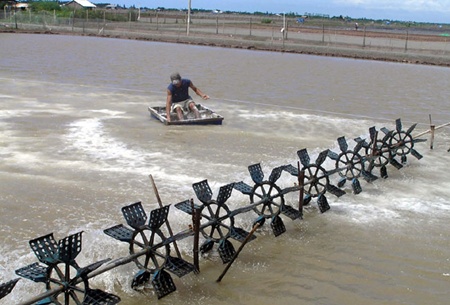Farmers ignore shrimp warning
 |
| A shrimp pond in the Mekong delta town of Bac Lieu. Overbreeding of the white-legged shrimp will damage the environment and cause disease outbreaks, agriculture officials have warned, but farmers are not paying any heed, local reports say. - VNA/VNS Photo Huynh Su. |
The breeding area for white-legged shrimp in the Cuu Long (Mekong) Delta province now covers about 10,000ha, 10 times higher than the province's planned figure, according to an official.
In the first eight months of the year, diseases have affected more than 1,740ha of white-legged shrimp.
Le Quy Thuy, head of the province's Department of Agriculture and Rural Development's Planning Division, said in some districts, the area of white-legged shrimp cultivation had increased by five times against the same period last year.
In Phuoc Long District, for instance, white-legged shrimp cultivation area had expanded from about 1,000ha last year to more than 5,000ha this year.
In Hong Dan and Dong Hai districts and Bac Lieu city, the area under white-legged shrimp cultivation had increased this year.
Farmers are breeding white-legged shrimp in northern districts, which are the traditional breeding areas of black-tiger shrimp, he said.
White-legged shrimp live in brackish or saline water and are normally bred in coastal areas.
Last year, the Cuu Long (Mekong) Delta farmers earned a high profit of about VND500 million (US$23,800) per ha for one crop of white-legged shrimp, which lasts about 70-90 days.
To reduce risk for farmers, the department has ordered its agencies to tighten management of the quality of shrimp fry, animal feed and medical and farming techniques.
The department has also told farmers to set up informal teams to breed white-legged shrimp.
Intercropping works
Bac Lieu farmers have intercropped several aquatic species or rotated rice and shrimp cultivation in paddy fields in recent years, earning high income.
Under the model, farmers have bred black-tiger shrimp, crabs and marble goby in the same pond, planted one rice crop and one black-tiger shrimp crop in the same paddy field each year, or planted vegetables around shrimp pond areas.
Phuoc Long District is one of the province's leading districts in carrying out the model.
Farmer Tran Thanh Minh, who owns 2.5ha of farming land in Phuoc Long's Phong Thanh Tay B Commune, said he had intercropped black-tiger shrimp, crabs and fish in ponds.
He earned a profit of VND200-300 million ($9,500-14,200) a year.
Phuoc Long has nearly 7,000ha of land farmed under the models, according to the Phuoc Long People's Committee.
Tran Van An, deputy chairman of the Phuoc Long People's Committee, said the models had helped farmers break the sole cultivation of shrimp and breed several other high-value aquatic species.
"The district will continue supporting farming techniques for farmers to expand the models," he said.
In the first nine months of the year, Bac Lieu's aquaculture output reached 137,000 tonnes, up 14 per cent against the same period last year.
Of the figure, shrimp output was 63,520 tonnes.
Bac Lieu has nearly 130,000 ha of shrimp and is the delta's second largest shrimp cultivation area, after Ca Mau Province.
What the stars mean:
★ Poor ★ ★ Promising ★★★ Good ★★★★ Very good ★★★★★ Exceptional
Latest News
More News
- Protect what’s next: towards a future free from meningococcal group B disease (December 05, 2025 | 18:00)
- New ILO report offers policy recommendations for disability inclusion (December 04, 2025 | 15:18)
- Maternal job loss may affect children’s mental health, research shows (December 03, 2025 | 19:11)
- Women lead Vietnam’s shift to climate-resilient agriculture (December 03, 2025 | 19:10)
- Experts highlight unpaid care work as key barrier to gender equality (December 03, 2025 | 15:15)
- Opportunities and inequalities for women workers in Vietnam's garment industry (December 03, 2025 | 09:00)
- Vietjet flights carry love to devastated central region (November 28, 2025 | 11:35)
- New initiative to boost the fight against domestic violence (November 26, 2025 | 10:00)
- South Korea funds IOM relief for Vietnam’s typhoon-affected communities (November 24, 2025 | 15:33)
- AI and human-centred values set to shape the future of HR in Vietnam (November 21, 2025 | 18:04)
















 Mobile Version
Mobile Version